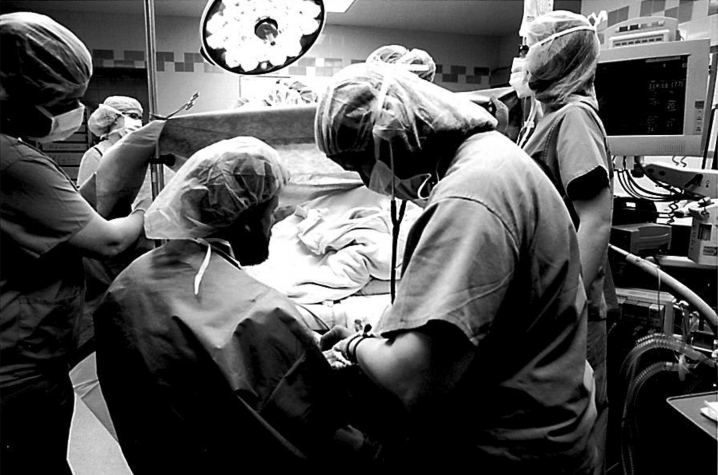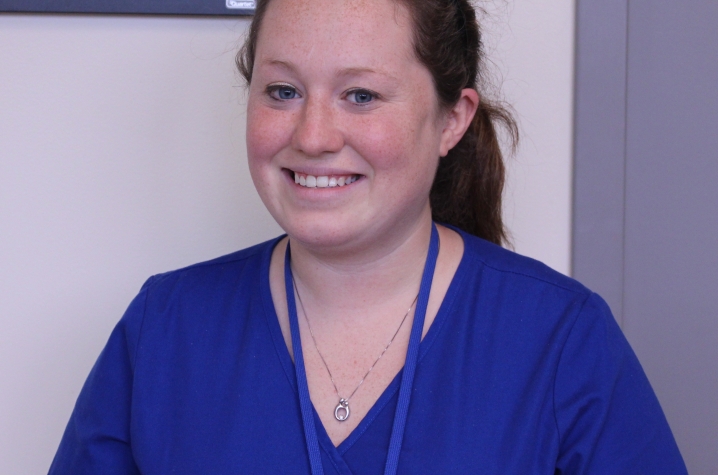KCH Pediatric Advanced Care Team at Family's Side Through Birth and Bereavement
LEXINGTON, Ky. (July 28, 2015) — Carrying a baby with a fatal heart condition, Morgan Drury was presented with a devastating picture of how her pregnancy might end. As soon as her fragile daughter received the gift of life, it would almost certainly be stripped away.
When Drury was nine weeks pregnant, a genetic test detected an abnormal chromosome in her baby Alex’s genetic makeup. Additional tests conducted at 12 weeks confirmed the genetic disorder caused a heart defect called hypoplastic left heart syndrome. In nine out of 10 cases, the condition is fatal.
After first coming to Kentucky Children’s Hospital, the Drury family sought out second opinions from pediatric heart specialists around the region. All returned with the same grim outlook: no medical intervention could save Alex’s life. Because of complications with her lungs, Alex wasn’t a surgical candidate. She wouldn’t survive the stress of traveling through the birth canal, so a cesarean section was the only option for keeping Alex alive during delivery. Doctors also questioned whether the pregnancy would remain viable until the time of delivery — most babies with Alex’s condition don’t survive the first trimester.
“We were told she would eventually stop growing, and more than likely she would be stillborn,” Drury said.
Soon, the Drury family became accustomed to getting “no” as an answer from health care workers. But in the midst of a dire prognosis, Drury couldn’t deny the image of Alex’s heartbeat flickering on an ultrasound monitor. A little heart doctors deemed unfixable continued to beat, and the baby continued to grow.
Drury decided to carry out the pregnancy until 36 weeks — giving her daughter a chance at life, even if that life was momentary. With mixed emotions and instances of self-doubt, Drury prepared for a cesarean section schedule for Dec. 31, 2014. The plan was to celebrate the birth of Alex, and then grieve her passing, before the close of the year.
During conversations with the Pediatric Advanced Care Team (PACT) at Kentucky Children’s Hospital, Drury learned not every question regarding Alex’s fate warranted a negative response. Dr. Lindsay Ragsdale, a KCH pediatrician and director of the PACT, met with Drury throughout her pregnancy to develop a birth plan specific to the needs and wishes of the family. PACT, which consists of Dr. Ragsdale, a pediatric intensive care unit doctor, a nurse practitioner, a social worker and a chaplain, is devoted to guiding families through the process of treating a seriously ill child and, in some cases, the bereavement process. PACT members empower families facing an inevitable loss by giving them options, affirming their medical decisions, and providing ongoing emotional support during the many stages bereavement.
“It seemed like everybody was telling her, ‘No, we can’t do anything,’” Ragsdale said. “I told her, ‘Sure, we can take pictures. We can make this a memory for your family that’s not all about saying no,’ and that was a turning point for her.”
Ragsdale, who completed a fellowship in pediatric palliative care at Children’s Hospital of Philadelphia, walks through the birth and dying process with patients whose babies and children suffer from a terminal illness or condition. Ragsdale said often families confronting the loss of a newborn baby aren’t fully aware of the opportunities to bond with their child, even if death is imminent. PACT professionals coordinate special services, such as newborn photography through Now I Lay Me Down to Sleep, and facilitate opportunities for families to create lifelong memories with their children.
“In my mind, there are always things we can do to make a situation that’s not optimal better for the family,” Ragsdale said.
Early in her medical training, Ragsdale remembers feeling helpless when a grieving mother asked her why her newborn baby was dying. While Ragsdale doesn’t always have answers to her patients’ toughest questions, she’s now more prepared to assist patients in a state of grief. Ragsdale believes patients shouldn’t have to bear the weight of making life and death decisions for their babies alone. PACT members share the decision-making process, so parents are reassured their children are receiving the most compassionate care from a medical professional’s perspective.
In Drury’s case, the PACT plan was designed to keep Alex safe, warm and comfortable until her passing. Drury expressed a desire to hold Alex as soon as possible, so the team arranged for maternal-fetal bonding immediately after the surgery. Ragsdale and Drury discussed the family’s wishes regarding the use of medication if the baby was experiencing discomfort after birth. The baby wouldn’t be bombarded with standard procedures or painful pricks. They discussed whether Alex would receive ointment and what clothes she would wear on the day of her birth. The team also addressed different scenarios and what to expect if each scenario should arise on delivery day. PACT informed Drury’s obstetrics team of the plan, so no question about Alex’s care was left unanswered on delivery day.
“It was a way she could control an out of control situation,” Ragsdale said of the PACT plan. “Parents want to help their kids, and making these plans is a way to put them in control.”
Drury’s only additional wish was to receive some sign of proof the baby was alive. A cry or a heartbeat — something only Alex could give.
On delivery day, Drury, overwhelmed with emotion, hesitated to check into the hospital. Ragsdale, who communicated with the family in the waiting room and was at Drury’s side during delivery, eased her patient’s stress by recounting the plan and describing the goals Drury originally set for Alex’s life. Drury believes having a PACT plan in place helped to create realistic expectations, keep Alex’s care fluid and prevent any surprises, which could have provoked more grief on an already emotional day.
“We were glad she was there because we had built that trust and a relationship,” Drury said of Ragsdale and the PACT. “They are not just there because that’s their job; you can tell that's what they want to be doing.”
The moment Alex was delivered, a sense of relief fell over Drury as she listened to her newborn baby cry. Ragsdale reported Alex’s arrival to family and friends waiting in the lobby, who received the news with joy and relief, but sorrow too. Immediately after surgery, Drury, her 2-year-old daughter Isabella and her husband Russ were able to hold, touch and bond with Alex. Nurses swaddled Alex in a blanket and put a cap on her head.
“That’s the part I love to see,” Ragsdale said. “They are beautiful parents and they cried over her and loved over her and really enjoyed looking at her face, and her ears, and her nose — and just seeing how cute she was.”
With no lingering questions about care or decisions to make in the moment, Drury was able to focus all her attention on the baby. Alex’s heart beat for three hours before Dr. Ragsdale officially called her passing. During this critical time, Drury was granted much-needed closure, which could only come from intimate time with her daughter.
“I just want proof of life — to know that she did live. I wanted her to tell us, ‘I'm okay,’” Drury said. “And she did just that. Then she went on peacefully.”
While Drury recovered from surgery, a pair of butterfly wings was hung on her hospital door to symbolize the passing of a child. Later, Drury got a tattoo of purple butterfly wings and Alex’s footprints as an enduring reminder of the daughter she lost.
“I still dream about her and look at her pictures — she is still my daughter,” Drury said. “But I have that sense of relief that I did what I had to do to keep her alive.”
Now 15 weeks into her third pregnancy, Drury, a nurse in the UK Department of Pediatrics, looks forward to welcoming another child, whose heart is developing healthy and strong.
MEDIA CONTACT: Elizabeth Adams, elizabethadams@uky.edu










